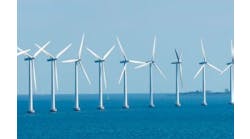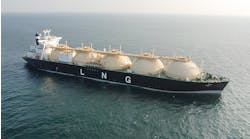Jeremy Beckman , London
Skarv-Idun set to deliver
BP finally has submitted its $5.247-billion plan for development and operation, and installation and operation of the Skarv-Idun fields in the Norwegian Sea. At one point, BP and its partners were targeting fall 2004 for first production, but circumstances since have delayed the project launch. Third quarter 2011 is the new start-up target.
Together, these fields represent one of Norway’s largest undeveloped resources, comprising 48.3 bcm (1.7 tcf) of rich gas and 105 MMbbl of oil and condensate. One of the main factors stalling progress had been the export route for the gas: this will feed through the Aasgard Transport System (ATS) via a new 80-km (49.7-mi), 26-in. (66-cm) pipeline. According to London-based analysts Scanboss, the ATS capacity will be upgraded by 5% to 26 bcm/yr (918 bcf/yr) to accommodate the two fields.
Earlier this year, BP contracted Samsung for the 40,000-metric ton (44,092-ton) hull for Skarv-Idun’s 292-m (958-ft) long, 50.6-m (166-ft) wide FPSO. In July, Samsung also won the $350-million contract for the 16,000-metric-ton (17,636-ton) topsides, comprising six modules and a flare tower. Scanboss reports there will be production capacity for 15 MMcm/d (530 MMcf/d) of gas and 85,000 b/d of liquids, with gas injection capacity of 5 MMcm/d (177 MMcf/d).
The vessel will be moored by a 4,000-metric-ton (4,409-ton) turret - the world’s largest for a floater, according to supplier Bluewater - with 15 mooring lines. Water depth in the development area, between the Heidrun and Norne fields, varies from 350 to 450 m (1,148-1,476 ft).
Among the other major contracts placed so far, VetcoGray will provide the $250-million subsea production system, which includes 17 wellhead/tree systems, five subsea templates with integrated manifolds, and workover, tie-in, and control systems. Engineering and subsequent operational support will take place at various VetcoGray locations in Norway and the UK.
BP says there is potential to tie in other fields and prospects to the FPSO at a later stage. These might include BP’s Graasel and Eni’s Marulk, but Scanboss believes there will be no spare capacity for further tiebacks for many years to come.
In the UK, BP also has announced a $250-million investment in new gas compression facilities at its terminal in Dimlington on the southern Yorkshire coast. These will allow it to shut down facilities at the nearby unmanned terminal in Easington.
The planned new equipment should reduce pipeline pressure between various field centers in the southern North Sea, allowing them to increase production. BP expects to increase recoverable reserves from its West Sole and Amethyst fields as a result of this project. Others tied into Dimlington are the Ravenspurn and Cleeton area fields, and various other third party installations.
Onyx development some way off
Norske Shell’s hopes of kick-starting another giant gas project were set back by its latest well on the Onyx field, again in the Norwegian Sea. The semisubmersibleWest Alpha drilled the well on the southwest of the structure and did find gas in Middle to Lower Jurassic rocks, but not enough to resolve uncertainty over the field’s size.
The Norwegian Petroleum Directorate (NPD) says reserves are “probably in the upper half of the uncertainty range” of its 10-50-bcm (353-1,767-bcf) recoverable estimate, issued in Jan. 2006. Norske Shell likely will switch its drilling focus to deepwater blocks west of Onyx in an attempt to find more gas, which might justify a joint development.
Statoil had better luck, albeit on a smaller scale, with an exploratory well on its Yttergrytta prospect on the Halten Terrace. The well, drilled by the semisubStena Don in 297 m (974 ft) of water, found gas in Mid-Jurassic sandstones 1-km (0.62-mi) east of the Midgard field. NPD’s preliminary estimate is 1-3 bcm (35-106 bcf) of recoverable gas, which could be developed via a subsea template and new pipeline to Midgard.
Drillers on the UK shelf had notable results appraising two important discoveries. Chevron’s latest well on its Rosebank prospect, 160 km (99 mi) northwest of the Shetlands, test flowed oil at choked rates of 6,000 b/d. The semisubTransocean Rather drilled the deviated well into the southern part of the structure and since has moved to its northern extent for a third appraisal well. Partner Statoil says the current program will determine whether a fasttrack development is feasible.
In the UK northern North Sea, Antrim Energy also proved further oil in Jurassic sandstone formations while appraising the Causeway discovery, testing at a combined rate of 6,300 b/d of light oil. The production-starved Thistle platform could provide a development option.
Costs overwhelming UK operators
Total expenditure across the UK continental shelf rose by $4.1 billion last year to over $23.6 billion, according to the latest Economic Report from Oil & Gas UK (formerly UKOOA). However, rising costs largely, rather than an upturn in activity, accounted for the increase.
Capital expenditure on field developments and associated drilling went up by $2 billion to $11.5 billion, but the fact that there was no substantial increase to delivery plans over this period suggests cost inflation approached 20%. Operating costs were up 15%, at $11.3 billion.
The report adds that the unit technical cost (UTC) of developing and producing a new barrel of oil or gas equivalent on the UK shelf rose 45% to $22/boe between 2005 and 2006. When the recent drop in UK gas prices and the effect of higher taxes are factored in, this shows that the UK’s competitiveness is being progressively reduced.
The authors predict that the average UTC for UK projects coming onstream this year and next will rise to $25/boe, with the result that some of the more cost-intensive planned developments may not go ahead. If that happens, future costs actually may ease, but with a consequent negative impact on production.
As for drilling, the report identifies a slight decline in exploration and appraisal well numbers last year to 69, due in part to the tight rig market. Most wells were targeted at the “safer” basins in the central and southern North Sea, although there may be an upsurge this year in the Atlantic margin, due to approaching deadlines for frontier license commitments.
Last year, combined reserves from new finds throughout the shelf were around 500 MMboe, with two accumulations probably above 100 MMboe. However, the average cost per well rose to $20.5 million, equating to a finding cost of $3/boe, somewhat higher than in recent years. The authors add that semisubmersible rig rates have risen eightfold on the UKCS in the past three years, while jackup costs have tripled over the same period.
Oil & Gas UK also commissioned consultants Wood Mackenzie to update an earlier survey into the UK’s future prospects. The main findings were that if more were done to improve investment efficiency, the industry could develop an additional 5 Bboe-plus. Also, 45% of UK infrastructure currently faces decommissioning by 2020, but this could be delayed by 10-15 years in many cases via incentives arising from changes to the fiscal and regulatory regimes.




